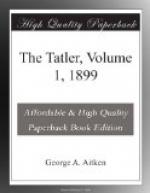These are the hard shifts we intelligencers are forced to; therefore our readers ought to excuse us, if a westerly wind blowing for a fortnight together, generally fills every paper with an order of battle; when we show our martial skill in each line, and, according to the space we have to fill, we range our men in squadrons and battalions, or draw out company by company, and troop by troop; ever observing, that no muster is to be made, but when the wind is in a cross point, which often happens at the end of a campaign, when half the men are deserted or killed. The Courant is sometimes ten deep, his ranks close: the Postboy[415] is generally in files, for greater exactness; and the Postman comes down upon you rather after the Turkish way, sword in hand, pell-mell, without form or discipline; but sure to bring men enough into the field; and wherever they are raised, never to lose a battle for want of numbers.
[Footnote 405: From George Whetstone’s “English Mirror,” 1586.]
[Footnote 406: See “Every Man out of his Humour,” act ii. sc. 1.]
[Footnote 407: Lady Elizabeth Hastings, unquestionably one of the most accomplished and virtuous characters of the age in which she lived, was the daughter of Theophilus Hastings, the 7th Earl of Huntingdon, and of Elizabeth, eldest daughter and co-heiress to John Lewes, of Ledstone, in Yorkshire, Knt. and Bart. Her father succeeded to the honours and estate of the family, Feb. 13, 1655, and was in 1687 Lord Chief Justice, and Justice in Eyre of all the King’s forests, &c., beyond Trent; Lord Lieutenant of the counties of Leicester and Derby; Captain of the Band of Gentlemen Pensioners, and of the Privy Council to King James II. He died suddenly at his lodgings in Charles Street, St. James’s, May 13, 1701, and was succeeded in his honours and estate by his son, and her brother, Charles, who died unmarried, Feb. 22, 1704. Lady Elizabeth Hastings was born April 19, 1682, and died Dec. 22, 1739. It is said, with great probability, that since the commencement of the Christian era, scarce any age has produced a lady of such high birth and superior accomplishments, that was a greater blessing to many, or a brighter pattern to all. There is an admirable sketch of this illustrious lady’s character, drawn soon after her death, in the tenth volume of the Gentleman’s Magazine, p. 36, probably by Samuel Johnson. See also “An historical Character relating to the holy and exemplary Life of the Right Honourable the Lady Elisabeth Hastings, &c. By Thomas Barnard, A.M. Printed at Leeds, in 1742, 12mo” (Nichols).—Lady Elizabeth Hastings, who came into a fortune upon the death of her brother George, Earl of Huntingdon, settled at Ledstone House, where she was the Lady Bountiful of the neighbourhood. Her whole estate, however, is said to have been less than L3000 a year. The best of the clergy of the day were among her friends. She helped Berkeley in his Bermuda Mission scheme,




